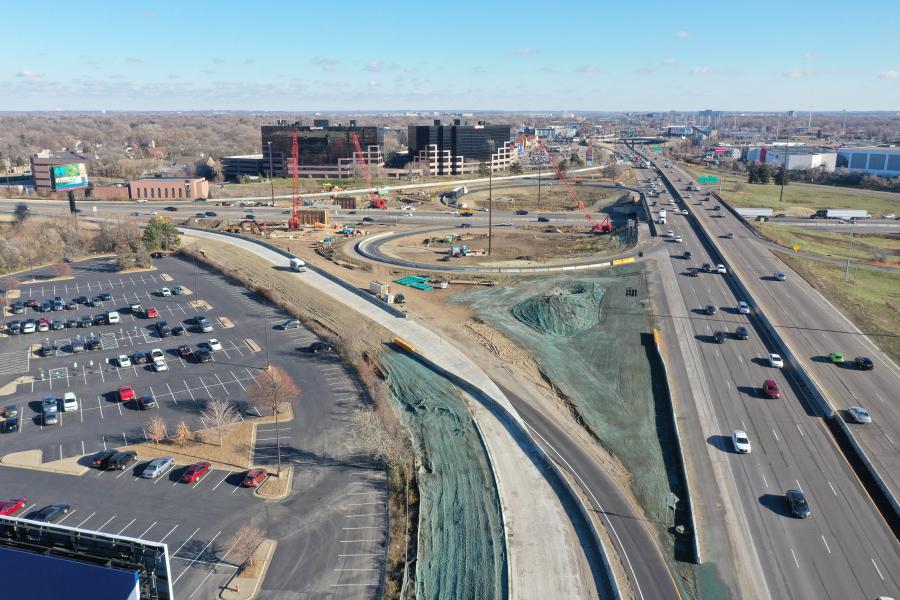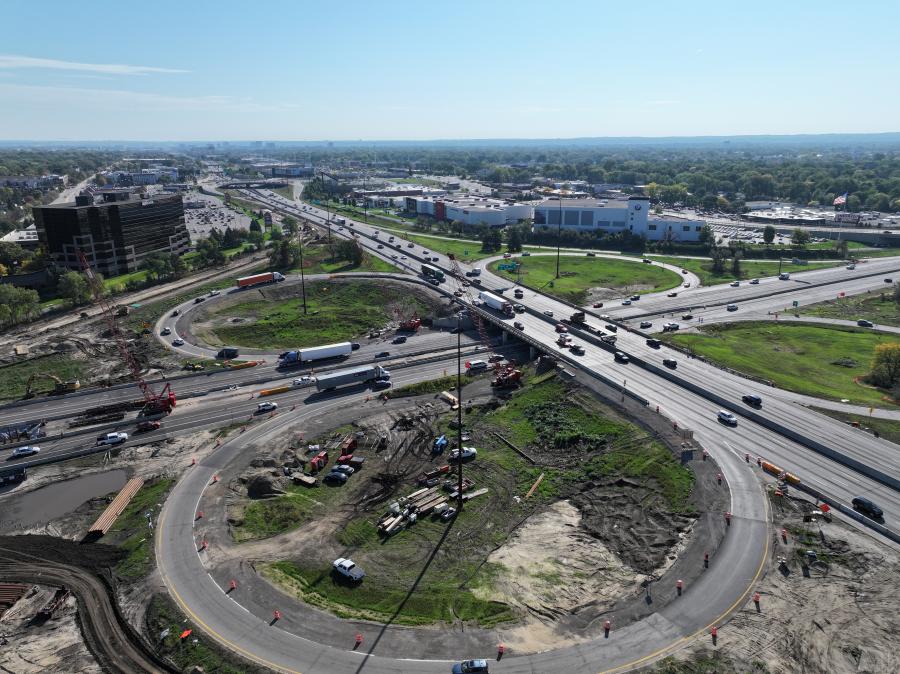Photo courtesy of MnDOT
Between 300,000 and 400,000 cu. yds. of dirt will be moved on the I-35 portion of the I-494 project.
Amidst frigid temperatures, construction crews in Minnesota worked on a turbine interchange designed to improve traffic operations and safety on both I-35W and I-494. As part of the $103 million project, the new ramp being built in the northeast corner of the interchange will enable vehicles heading northbound I-35W to WB I-494 to move more efficiently.
"The turbine [flyover] ramp from NB 35W to WB 494 is higher speed and allows traffic to flow more freely than the current cloverleaf loop," explained Tim Clyne, I-494 construction project manager. "The other main feature of the interchange is the three braid bridges [two at Penn and 494 and one at 35W and 82nd Street] that eliminate weaving between traffic entering and exiting the ramps.
"The 82nd Street braid bridge [27W50] eliminates weaving between traffic entering northbound 35W from 82nd Street and exiting northbound 35W to 494. Traffic exiting 35W to 494 also is separate from traffic entering northbound 35W from eastbound 494. These two movements currently involve high volumes of traffic weaving over short distances, which leads to congestion and crashes."
As part of the work, storm sewer pipes and drainage structures will be rebuilt, as well as several stormwater ponds/BMPs to improve water quality and reduce flooding potential on 35W. Some utilities will be relocated, including a sanitary sewer for the city of Richfield. Signing, lighting and intelligent transportation systems also will be upgraded.

Photo courtesy of MnDOT
Work on the interchange began in summer 2023 and is expected to be complete by fall 2025. Clyne said construction is being performed in phases.
"Reconstructing the entire interchange is a huge job that can't be done all at once. We need to maintain traffic lanes along 494 and 35W, as well as the two largest ramp movements [northbound to westbound and eastbound to southbound] at all times."
Regarding traffic conditions, said Clyne, "We have seen moderate increases in congestion throughout the corridor, but most people are adapting well. Dynamic message signs placed throughout the metro area inform travelers of travel times to key locations along 494 and give them alternate routes. Detours are well-marked, so even if some roads or ramps are closed, people are still able to get to their destination without too much hassle."
C.S. McCrossan serves as the contractor on the project.
"McCrossan was the best value proposer out of three teams who bid on the project," said Clyne. "They have built many of the projects along 494 over the last 20 years and have a long history of constructing design-build projects in Minnesota."
According to Clyne, the two biggest challenges in constructing the interchange are keeping the project on schedule and maintaining traffic through the interchange during construction. Crews also must deal with numerous utilities, along with contaminated soil and groundwater.
Clyne noted that I-35 work is ongoing, even though outdoor conditions make the work more difficult.
"Over the winter, construction slowed down but did not stop. Crews worked on building the abutments of the flyover bridge [27W49], and they set beams in January. They also are widening bridge 6850 [WB 494 over 35W]. The pier and abutments are complete. Crews also are performing pipe jacking for various utilities along 494 and grading for stormwater BMPs."
In addition, several areas of temporary pavement and drainage have already been constructed in preparation for staging traffic.
Clyne said construction of the turbine ramp bridge over I-35W required a great deal of planning and coordination.
"Steel circular piles were pounded to a depth of approximately 70 feet for both abutments and the center pier. Then they built forms, set reinforcing steel and poured the concrete footings. Reinforcement continued for the abutments and pier stems, followed again by concrete pours.
A final set of reinforcement and concrete was added for the center pier cap and the wing walls coming off each abutment. Special instrumentation is in place to monitor temperatures of the concrete as the abutment cures and strain/deflection of the piles, as the abutments are backfilled.
"Precast concrete beams were set in mid-January," said Clyne. "Crews continued to work over the winter setting forms and placing reinforcing steel for the deck. As soon as temperatures are warm enough in the spring, they will pave the concrete bridge deck and the railings."
Building retaining walls and grading on either side is a process, starting with a thorough geotechnical investigation and analysis to characterize the existing soils.
"Then the contractor decides what type of retaining walls to build, based on the site conditions and contract requirements regarding drainage, utilities, geometry and other considerations. The four walls adjacent to the 27W49 turbine bridge are all Mechanically Stabilized Earth [MSE] walls. Then the roadway engineer designs the alignment and profile of the walls, followed by the actual wall design by a structural engineer.

Photo courtesy of MnDOT
"After all these steps, the plans finally make it out to construction. A preload surcharge will be added in one area to address settlement concerns over soft soils. The contractor surveys and stakes the specific locations of the walls and excavates to the proper elevation. Then they build forms, set reinforcing steel and pour the concrete spread footing. The MSE wall is built in several alternating lifts of granular material and geotextile reinforcement straps all the way up to the top."
Drain tile also is added in specific locations to account for subsurface drainage. Finally, precast concrete panels are added to the front face of the wall, which have a pattern adhering to the visual quality requirements of the project.
After the retaining walls are constructed, the roadway crews can complete grading and paving of the ramps approaching the turbine bridge. Concrete barrier and their supporting slabs also are built at this time.
Despite the cold weather, construction on structures continues throughout the winter; however, work that affects mainline traffic is suspended between mid-November and early April.
"You can't place water and compact grading materials on frozen ground," said Clyne. "It snows a lot in Minnesota and covers the ground. Daylight hours are limited. Crews don't like to work in cold weather, and efficiency is limited.
Between 300,000 and 400,000 cu. yds. of dirt will be moved on the I-35 portion of the I-494 project. Heavy equipment required to complete the highway project includes cranes, backhoes, dozers, rollers, blades, trimmers, asphalt and concrete pavers, vac trucks, curb machines, median barrier machines and bridge pavers.
Main materials include sand/granular material from local pits, aggregate base made on site from recycled concrete and bituminous pavement, new concrete and bituminous pavement, precast concrete bridge beams, cast in place and MSE (using geosynthetic reinforcement) retaining walls, precast concrete noise walls, precast concrete pipe and drainage structures, signal systems, overhead signs, dynamic message signs, cabling and electronics.
MnDOT communications coordinator Jesse Johnson said that while the majority of construction has yet to be carried out, the hours invested will be time well spent.
"It is always enjoyable to work on a project that offers safety benefits, while also improving the travel experience of everyone who uses the road. It's nice to be on a project that, once completed, will impact the lives of so many people in a positive way." CEG
Today's top stories

















